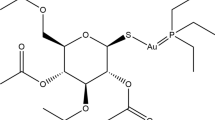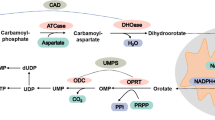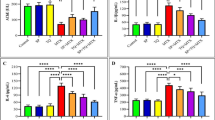Methotrexate (MTX), a folate antagonist, was developed for the treatment of malignancies, and is currently used in rheumatoid arthritis (RA) and other chronic inflammatory disorders. It has been proven in short-term and long-term prospective studies that low doses of MTX (0.75 mg/Kg/week) are effective in controlling the inflammatory manifestations of RA. Low-concentrations of MTX achieve apoptosis and clonal deletion of activated peripheral T cells. One of the mechanisms of the anti-inflammatory and immunosuppressive effects may be the production of reactive oxygen species (ROS). However, the drug resistance of MTX in malignancies remains poorly understood. Ornithine decarboxylase (ODC) plays an important role in diverse biological functions, including cell development, differentiation, transformation, growth and apoptosis. In our previous studies, ODC overexpression was shown to prevent TNFα-induced apoptosis via reducing ROS. Here, we also investigated one mechanism of MTX-induced apoptosis and of drug resistance as to the anti-apoptotic effects of ODC during MTX treatment. We found MTX could induce caspase-dependent apoptosis and promote ROS generation together with disrupting the mitochondrial membrane potential (ΔΨm) of HL-60 and Jurkat T cells. Putrescine and ROS scavengers could reduce MTX-induced apoptosis, which leads to the loss of ΔΨm, through reducing intracellular ROS. Overexpression of ODC in parental cells had the same effects as putrescine and the ROS scavengers. Moreover, ODC overexpression prevented the decline of Bcl-2 that maintains ΔΨm, the cytochrome c release and activations of caspase 9 and 3 following MTX treatment. The results demonstrate that MTX-induced apoptosis is ROS-dependent and occurs along a mitochondria-mediated pathway. Overexpressed ODC cells are resistant to MTX-induced apoptosis by reducing intracellular ROS production.
Similar content being viewed by others
References
DeVita VT, Hellman S, Rosenberg SA. Principles & Practice of Oncology. In: Cancer. Lippincott Williams & Wilkins 2001: 388.
Meyers PA, Gorlick R, Heller G, et al. Intensification of preoperative chemotherapy for osteogenic sarcoma: results of the Memorial Sloan-Kettering (T12) protocol. J Clin Oncol 1998; 16: 2452–2458.
Silverman LB, McLean TW, Gelber RD, et al. Intensified therapy for infants with acute lymphoblastic leukemia: results from the Dana-Farber Cancer Institute Consortium. Cancer 1997; 80: 2285–2295.
Williams SF, Gilewski T, Mick R, Bitran JD. High-dose consolidation therapy with autologous stem-cell rescue in stage IV breast cancer: follow-up report. J Clin Oncol 1992; 10: 1743–1747.
Barry MA, Behnke CA, Eastman A. Activation of programmed cell death (apoptosis) by cisplatin, other anticancer drugs, toxins and hyperthermia. Biochem Pharmacol 1990; 40: 2353–2362.
Friesen C, Herr I, Krammer PH, Debatin KM. Involvement of the CD95 (APO-1/FAS) receptor/ligand system in drug-induced apoptosis in leukemia cells. Nat Med 1996; 2: 574–577.
da Silva CP, de Oliveira CR, da Conceicao M, de Lima P. Apoptosis as a mechanism of cell death induced by different chemotherapeutic drugs in human leukemic T-lymphocytes. Biochem Pharmacol 1996; 51: 1331–1340.
Muller M, Strand S, Hug H, et al. Drug-induced apoptosis in hepatoma cells is mediated by the CD95 (APO-1/Fas) receptor/ligand system and involves activation of wild-type p53. J Clin Invest 1997; 99: 403–413.
Heenen M, Laporte M, Noel JC, de Graef C. Methotrexate induces apoptotic cell death in human keratinocytes. Arch Dermatol Res 1998; 290: 240–245.
Genestier L, Paillot R, Fournel S, Ferraro C, Miossec P, Revillard JP. Immunosuppressive properties of methotrexate: apoptosis and clonal deletion of activated peripheral T cells. J Clin Invest 1998; 102: 322–328.
Paillot R, Genestier L, Fournel S, Ferraro C, Miossec P, Revillard JP. Activation-dependent lymphocyte apoptosis induced by methotrexate. Transplant Proc 1998; 30: 2348–2350.
Phillips DC, Woollard KJ, Griffiths HR. The anti-inflammatory actions of methotrexate are critically dependent upon the production of reactive oxygen species. Br J Pharmacol 2003; 138: 501–511.
Miyashita T, Reed JC. bcl-2 gene transfer increases relative resistance of S49.1 and WEHI7.2 lymphoid cells to cell death and DNA fragmentation induced by glucocorticoids and multiple chemotherapeutic drugs. Cancer Res 1992; 52: 5407–5411.
Kitada S, Takayama S, De Riel K, Tanaka S, Reed JC. Reversal of chemoresistance of lymphoma cells by antisense-mediated reduction of bcl-2 gene expression. Antisense Res Dev 1994; 4: 71–79.
Papaconstantinou HT, Xie C, Zhang W, et al. The role of caspases in methotrexate-induced gastrointestinal toxicity. Surgery 2001; 130: 859–865.
Tabor CW, Tabor H. Polyamines. Annu Rev Biochem 1984; 53: 749–790.
Thomas T, Thomas TJ. Polyamines in cell growth and cell death: molecular mechanisms and therapeutic applications. Cell Mol Life Sci 2001; 58: 244–258.
Moshier JA, Dosescu J, Skunca M, Luk GD. Transformation of NIH/3T3 cells by ornithine decarboxylase overexpression. Cancer Res 1993; 53: 2618–2622.
Auvinen M, Laine A, Paasinen-Sohns A, et al. Human ornithine decarboxylase-overproducing NIH3T3 cells induce rapidly growing, highly vascularized tumors in nude mice. Cancer Res 1997; 57: 3016–3025.
Quemener V, Moulinoux JP, Havouis R, Seiler N. Polyamine deprivation enhances antitumoral efficacy of chemotherapy. Anticancer Res 1992; 12: 1447–1453.
Bachrach U, Shayovitz A, Marom Y, Ramu A, Ramu N. Ornithine decarboxylase—a predictor for tumor chemosensitivity. Cell Mol Biol (Noisy-le-grand) 1994; 40: 957–964.
Ploszaj T, Motyl T, Zimowska W, Skierski J, Zwierzchowski L. Inhibition of ornithine decarboxylase by alpha-difluoromethylornithine induces apoptosis of HC11 mouse mammary epithelial cells. Amino Acids 2000; 19: 483–496.
Park JK, Chung YM, Kang S, et al. c-Myc exerts a protective function through ornithine decarboxylase against cellular insults. Mol Pharmacol 2002; 62: 1400–1408.
Liu GY, Chen KJ, Lin-Shiau SY, Lin JK. Peroxyacetyl nitrate-induced apoptosis through generation of reactive oxygen species in HL-60 cells. Mol Carcinog 1999; 25: 196–206.
Kao MC, Liu GY, Chuang TC, Lin YS, Wuu JA, Law SL. The N-terminal 178-amino-acid domain only of the SV40 large T antigen acts as a transforming suppressor of the HER-2/neu oncogene. Oncogene 1998; 16: 547–554.
Hour TC, Chen L, Lin JK. Suppression of transcription factor NF-kappaB activity by Bcl-2 protein in NIH3T3 cells: implication of a novel NF-kappaB p50-Bcl-2 complex for the anti-apoptotic function of Bcl-2. Eur J Cell Biol 2000; 79: 121–129.
Kunkel TA. Rapid and efficient site-specific mutagenesis without phenotypic selection. Proc Natl Acad Sci USA 1985; 82: 488–492.
Wang Y, Bachrach U. A luminescence-based test for determining ornithine decarboxylase activity. Anal Biochem 2000; 287: 299–302.
Amer J, Goldfarb A, Fibach E. Flow cytometric measurement of reactive oxygen species production by normal and thalassaemic red blood cells. Eur J Haematol 2003; 70: 84–90.
Carter WO, Narayanan PK, Robinson JP. Intracellular hydrogen peroxide and superoxide anion detection in endothelial cells. J Leukoc Biol 1994; 55: 253–258.
Juan G, Cavazzoni M, Saez GT, O’Connor JE. A fast kinetic method for assessing mitochondrial membrane potential in isolated hepatocytes with rhodamine 123 and flow cytometry. Cytometry 1994; 15: 335–342.
Davis S, Weiss MJ, Wong JR, Lampidis TJ, Chen LB. Mitochondrial and plasma membrane potentials cause unusual accumulation and retention of rhodamine 123 by human breast adenocarcinoma-derived MCF-7 cells. J Biol Chem 1985; 260: 13844–13850.
McConkey DJ, Lin Y, Nutt LK, Ozel HZ, Newman RA. Cardiac glycosides stimulate Ca2+ increases and apoptosis in androgen-independent, metastatic human prostate adenocarcinoma cells. Cancer Res 2000; 60: 3807–3812.
Kerr JF, Wyllie AH, Currie AR. Apoptosis: A basic biological phenomenon with wide-ranging implications in tissue kinetics. Br J Cancer 1972; 26: 239–257.
Wang H, Joseph JA. Quantifying cellular oxidative stress by dichlorofluorescein assay using microplate reader. Free Radic Biol Med 1999; 27: 612–616.
Ubezio P, Civoli F. Flow cytometric detection of hydrogen peroxide production induced by doxorubicin in cancer cells. Free Radic Biol Med 1994; 16: 509–516.
Shantz LM, Guo Y, Sawicki JA, Pegg AE, O’Brien TG. Overexpression of a dominant-negative ornithine decarboxylase in mouse skin: effect on enzyme activity and papilloma formation. Carcinogenesis 2002; 23: 657–664.
Hockenbery DM, Oltvai ZN, Yin XM, Milliman CL, Korsmeyer SJ. Bcl-2 functions in an antioxidant pathway to prevent apoptosis. Cell 1993; 75: 241–251.
Miyashita T, Reed JC. Bcl-2 oncoprotein blocks chemotherapy-induced apoptosis in a human leukemia cell line. Blood 1993; 81: 151–157.
Simonian PL, Grillot DA, Nunez G. Bcl-2 and Bcl-XL can differentially block chemotherapy-induced cell death. Blood 1997; 90: 1208–1216.
Genestier L, Paillot R, Quemeneur L, Izeradjene K, Revillard JP. Mechanisms of action of methotrexate. Immunopharmacology 2000; 47: 247–257.
Bertino JR. Karnofsky memorial lecture. Ode to methotrexate. J Clin Oncol 1993; 11: 5–14.
Bertino JR, Goker E. Drug resistance in acute leukemia. Leuk Lymphoma 1993; 11: 37–41.
Chabner BA. The evolution of cancer chemotherapy. Hosp Pract (Off Ed) 1985; 20: 115–119, 123–127.
Chabner BA, Allegra CJ, Curt GA, et al. Polyglutamation of methotrexate. Is methotrexate a prodrug? J Clin Invest 1985; 76: 907–912.
Quemeneur L, Gerland LM, Flacher M, Ffrench M, Revillard JP, Genestier L. Differential control of cell cycle, proliferation, and survival of primary T lymphocytes by purine and pyrimidine nucleotides. J Immunol 2003; 170: 4986–4995.
Muller M, Wilder S, Bannasch D, et al. p53 activates the CD95 (APO-1/Fas) gene in response to DNA damage by anticancer drugs. J Exp Med 1998; 188: 2033–2045.
Babiak RM, Campello AP, Carnieri EG, Oliveira MB. Methotrexate: Pentose cycle and oxidative stress. Cell Biochem Funct 1998; 16: 283–293.
Armstrong JS, Jones DP. Glutathione depletion enforces the mitochondrial permeability transition and causes cell death in Bcl-2 overexpressing HL60 cells. Faseb J 2002; 16: 1263–1265.
Gressier B, Lebegue S, Brunet C, et al. Pro-oxidant properties of methotrexate: evaluation and prevention by an anti-oxidant drug. Pharmazie 1994; 49: 679–681.
Yi J, Gao F, Shi G, et al. The inherent cellular level of reactive oxygen species: One of the mechanisms determining apoptotic susceptibility of leukemic cells to arsenic trioxide. Apoptosis 2002; 7: 209–215.
Ha HC, Sirisoma NS, Kuppusamy P, Zweier JL, Woster PM, Casero RA. Jr. The natural polyamine spermine functions directly as a free radical scavenger. Proc Natl Acad Sci USA 1998; 95: 11140–11145.
Morgan DM. Polyamines. An overview. Mol Biotechnol 1999; 11: 229–250.
Nesher G, Osborn TG, Moore TL. In vitro effects of methotrexate on polyamine levels in lymphocytes from rheumatoid arthritis patients. Clin Exp Rheumatol 1996; 14: 395–399.
Author information
Authors and Affiliations
Corresponding author
Rights and permissions
About this article
Cite this article
Huang, C.C., Hsu, P.C., Hung, Y.C. et al. Ornithine decarboxylase prevents methotrexate-induced apoptosis by reducing intracellular reactive oxygen species production. Apoptosis 10, 895–907 (2005). https://doi.org/10.1007/s10495-005-2947-z
Issue Date:
DOI: https://doi.org/10.1007/s10495-005-2947-z




